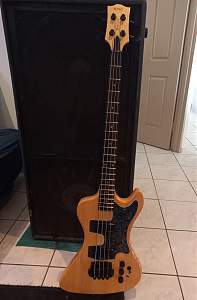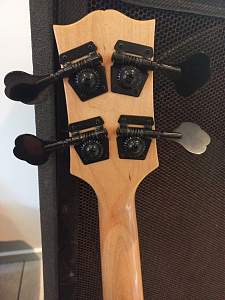Howdy,
In June 2020 I purchased a Pitbull SSR4 bass kit thinking I would have it completed by Christmas. Last year.
Life and other things got in the way, and I think I have purchased 2 or 3 additional basses and guitars since that time as well.
The idea behind purchasing the SSR4 kit was simply that I always thought that the Gibson RD Artist was the ultimate rock bass shape - and so I set out to build my ultimate rock bass. I tend cover a number of genres as a freelance bass player, but apart from a mid 90's Belman and a 10yr MTD that struggles in the tropics, I never had anything that I could comfortably use on a hard rock/metal gig. I have built a number of my other basses (including a Pitbull JB5 that I bought used/semi-completed), and restored others, so the building process wasn't that much of a challenge - I just needed a sound platform that I could pimp.
Along the way the bass christened itself 'Artie'...
A list of tweaks to the kit as delivered are as follows, with pics of the bass below...
- Black hardware replaces chrome hardware.
- ...including Hipshot high mass bridge for Gibson basses
- String-through-body ferrules installed (as per the Gibson version)
- Tuners installed slightly on angle towards the player 'Warwick style'
- Pickups replaced with Seymour Duncan Blackout active soapbars
- Custom circuit V/T/T, with 3 way pickup selector
- Foil lining to all cavities
- Flat/wide Hi-fi type knobs
- Custom black pearl pickguard - pretty much the same shape but some angles changes
- Truss rod cover replaced with metal Gibson bell copy
- Generic straplocks
- ...and strung with DR Low-Riders 45-105
The nut is left alone as it seems to sound fine for now.
The body is stained with the Dingotone butterscotch stain and the headstock remains clear with my own custom logo, instrument name, and my reference number.
Top coats of the body, neck and head are hand rubbed Tru-oil, applied over a couple of weekends to a high gloss level and finished off with Tru-oil gunstock wax.
I collected all the new hardware items from various online sources over the final three months of 2020 and the body sat under my bed for just on a full 12 months before commencing the build. The kit parts went together smoothly without any problems at all, even when swapping out the original hardware for the new items. When stringing, the intonation was easy enough to dial-in after the nut was grooved out a little.
I positioned the neck strap pin in the original location, which meant drilling through the neckplate to attach the pin. The bridge strap pin was moved off-centre towards the top of the body approx. 30mm from centre-line of strings in order to minimise head-dive while playing. I have a reverse-body bass and a Tele bass, along with a vintage Electa/Global SG bass, which all suffer head-dive due to poor balancing. The relocation of the strap pin goes a long way to solving that issue.
Apart from finding time, the only real challenge I had was finding tone-caps to give me sufficient tonal variety from the pickups. While the Blackout pups are suited to metal playing, what I didn't realise is that due to such a hot signal from the in-pickup circuitry, the preferred way of installing these soapbars is to bypass any tone pot at all and just dial in the required tone through the players amp. Consequently I ended up using a pair of .82uF caps in the tone circuits rather than the more common .047uF cap. Sometimes I wonder about still going bigger with the caps.
The control cavity is fortunately large enough to stow away the 9v battery, which is now tucked in there with a layer of bubble wrap between it and the other components.
My final playing action is a tad higher than I normally would like, but at this stage I will leave it and see how it goes, knowing that this bass will not be played lightly.
I think that's about all for now - I can't wait to get it out to rehearsals this week...
If you're still with me by now, thanks for reading.
Wayne - Darwin.








 Reply With Quote
Reply With Quote


